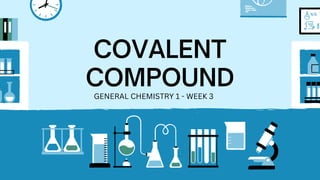
Covalent compound
- 1. COVALENT COMPOUND GENERAL CHEMISTRY 1 - WEEK 3
- 2. LEARNING OBJECTIVES: 1. illustrate how covalent compounds are formed 2. apply the octet rule in the formation of covalent compounds 3. draw the Lewis structure of covalent compounds 4. draw the resonance structures of covalent compounds 5. describe some exceptions of the octet rule 6. name covalent compounds given their formula and write formula given the name of covalent compounds 7. identify covalent compounds that are used in everyday living
- 3. KEY CONCEPTS - COVALENT COMPOUNDS are formed when a pair of electrons are shared between nonmetals. - OCTET RULE states that when atoms gain, lose, or share electrons to form bonds with other atoms they tend to achieve the electron configuration of the noble gas nearest to them with eight valence electrons. - There are three types of covalent bonds namely SINGLE BOND, DOUBLE BOND and TRIPLE BOND. - Bonding electrons are electrons shared between atoms. - Nonbonding electrons are electrons that does not participating in bonding or not shared between other atoms
- 4. Step 1. Determine the valence electrons of every atom involved. Step 2. Get the sum of the all the valence electrons of atoms. Step 3. Use a pair of electrons to form a single bond between atoms. Step 4. Arrange the remaining electrons around the atom to satisfy the octet rule except for Hydrogen which is stable with 2 valence electrons. - Steps in drawing the Lewis structures of compounds - LEWIS STRUCTURE shows how electrons are arranged in an atom.
- 6. Example: Draw the Lewis structure of F2 Step 1. Determine the valence electrons of every atom involved. Fluorine from group 7 (7 valence electrons) Step 2. Get the sum of the all the valence electrons of atoms. Total valence electrons: Fluorine = 7 valence electrons x 2 atoms =14 electrons Step 3. Use a pair of electrons to form a single bond between atoms F —F (—)single line bond is equivalent to 2 electrons 14 electrons – 2 electrons = 12 electrons
- 7. Step 4. Arrange the remaining electrons around the atom to satisfy the octet rule except for Hydrogen which is stable with 2 valence electrons Check: Count the number of valence electrons whether each atom of Fluorine satisfies the octet rule. Fluorine = bonding electrons + nonbonding electrons Fluorine = (1 x 2 e-) + 6 e- Fluorine = 2 e- + 6 e- Fluorine = 8 e-
- 8. Step 1. Carbon from group 4A (4 valence electrons); Chlorine from group 7A (7 valence electrons) Step 2. Carbon = 4 valence electrons x 1 atom =4 electrons Chlorine = 7 valence electrons x 4 atoms = 28 electrons Total valence electrons = 4 e-+28 e- = 32 e- Step 3. The least electronegative atom occupies the central position. Example: Draw the Lewis structure of CCl4
- 9. Step 4. Check: Count the number of valence electrons whether each atom satisfies the octet rule. Carbon = bonding electrons + nonbonding electrons Carbon = (4 x 2e- + 0 Carbon = 8 e- Chlorine = bonding electrons + nonbonding electrons Chlorine = (1 x 2 e-+ e- Chlorine = 2 e- + 6 e- Chlorine = 8 e-
- 10. Example: Draw the Lewis structure of CO2 Step 1. Carbon (4 valence electrons); Oxygen (6 valence electrons) Step 2. Carbon = 4 valence electrons x 1 atom =4 electrons Oxygen = 6 valence electrons x 2 atoms = 12 electrons Total valence electrons = 4 e- + 12 e- =16 e- Step 3. The least electronegative occupies the central position O—C—O
- 11. Step 4:
- 12. Check: Count the number of valence electrons whether each atom satisfies the octet rule. Carbon = bonding electrons + nonbonding electrons Carbon = 4 x 2e- Carbon = 8e- Oxygen = bonding electrons + nonbonding electrons Oxygen = (2 x 2e-)+4e- Oxygen = 8e-
- 13. LEWIS STRUCTURE AND RESONANCE
- 14. EXCEPTIONS TO THE OCTET RULE - The octet rule has limitations in many situations involving covalent bonding. These exceptions to the octet rule are of three main types: 1. Molecules with fewer than an octet of valence electrons. This type of exception occurs when there are fewer than eight valence electrons around the central atom. An example of this case is BeH2, Beryllium Hydride. H— Be— H There are only 4 electrons around Be atom.
- 15. 2. Molecules containing an odd number of electrons. Nitric oxide (NO) and nitrogen dioxide (NO2) are examples of molecules with odd number of electrons which do not follow the octet rule. 3. Molecules with more than an octet of valence electrons. Elements along the 3rd period and beyond have 3d orbitals that can participate in chemical bonding. Hence, it is possible for the central atoms from 3rd period and beyond to have expanded. Sulfur hexafluoride (SF6) and phosphorus pentachloride (PCl5) are examples of compound having more than 8 electrons around the central atom.
- 17. For binary compound, state the name of the first element while the name of the second element end in -ide. Example: HCl - Hydrogen chloride HF - Hydrogen fluoride Prefixes are added to the name of the element to denote the number of atoms present. For the first element, the prefix “mono” is usually omitted. When the prefix ends in “a” or “o” and the name of the second element begins with “a”vowel, the “a” or “o” of the prefix is often dropped. Guidelines in naming covalent compounds and writing their formulas:
- 18. Example 1: Write the name of the following covalent compounds. NO2 - nitrogen DIoxide N2O4 - DInitrogen TETRoxide SF6 - sulfur HEXAfluorid Example 2: Write the chemical formula of covalent compounds. sulfur TRIoxide - SO3 DIboron TRIOxide - B2O3 iodine PENTAfluoride - IF5